



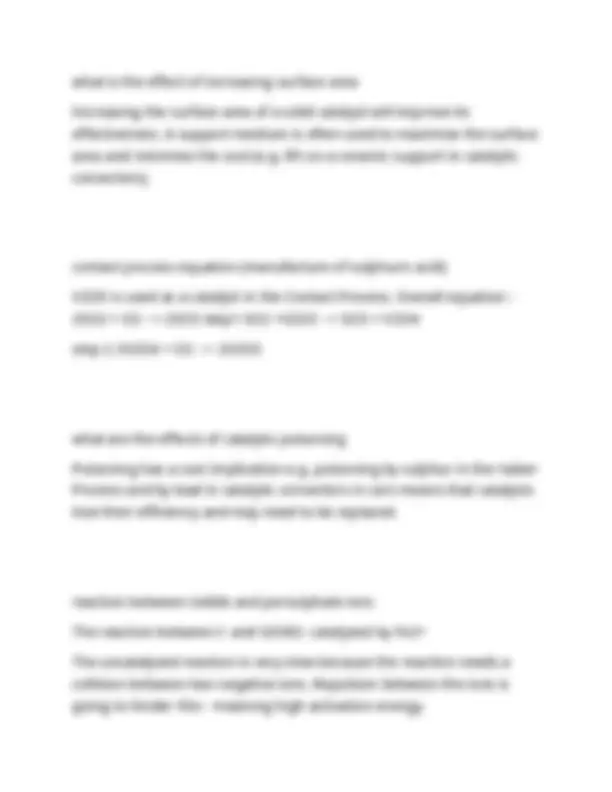
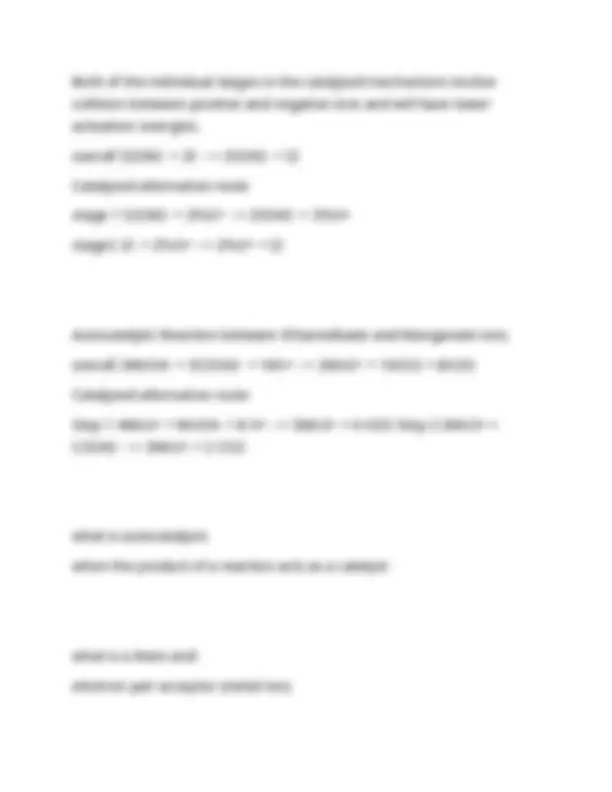

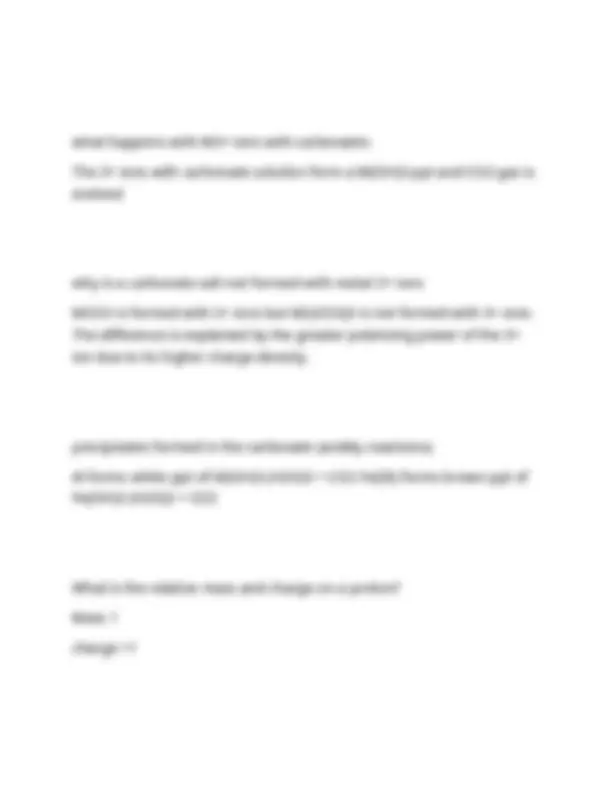
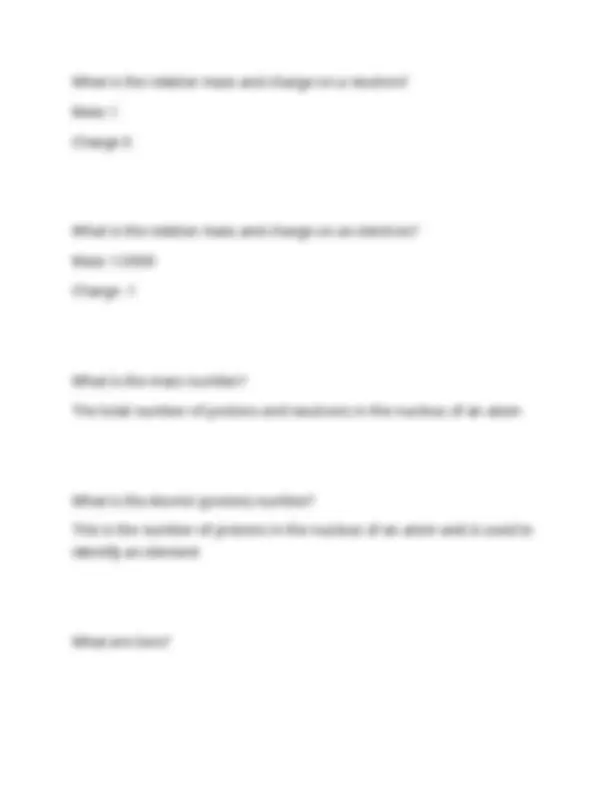
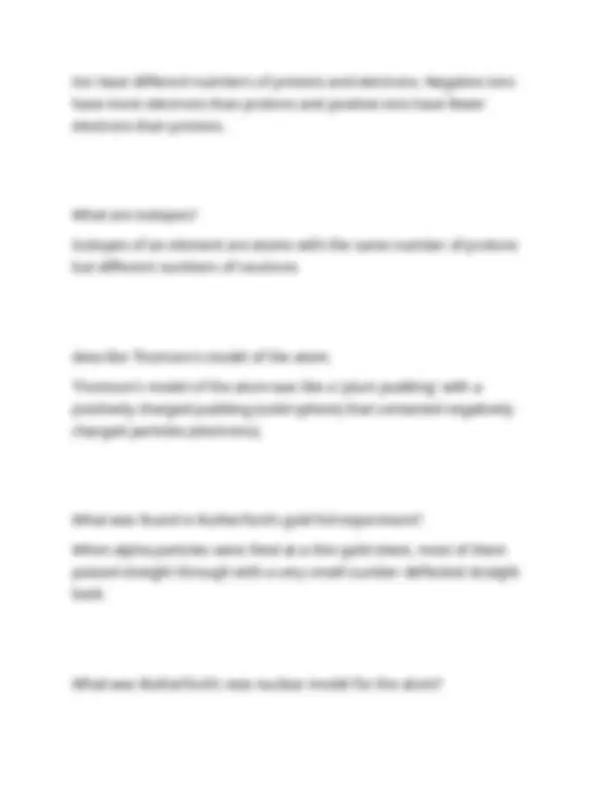
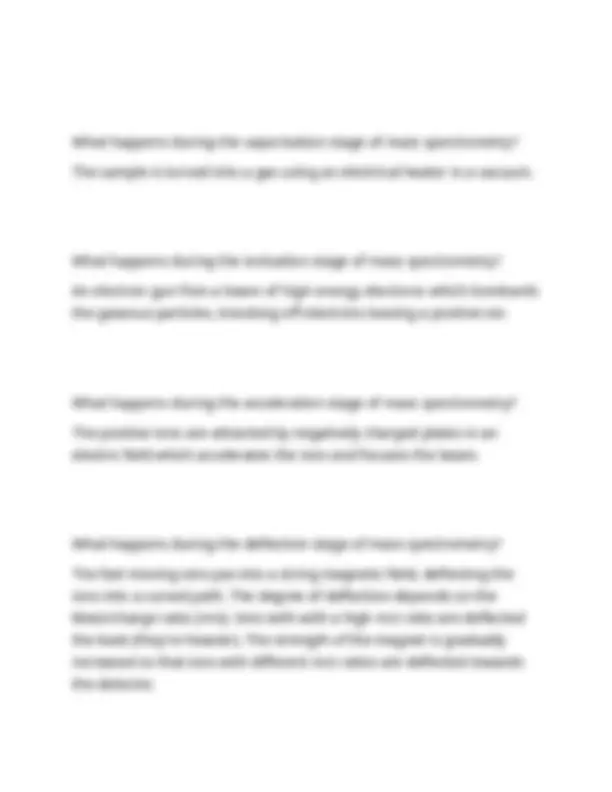
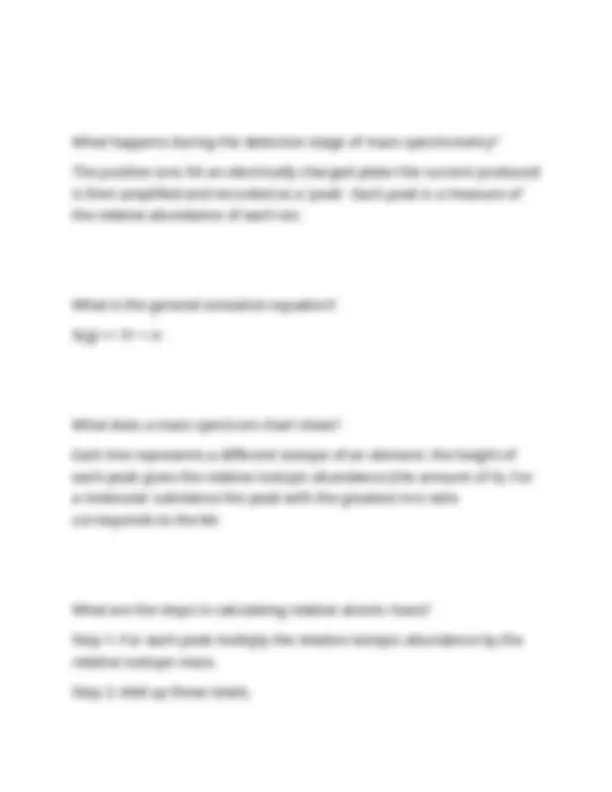
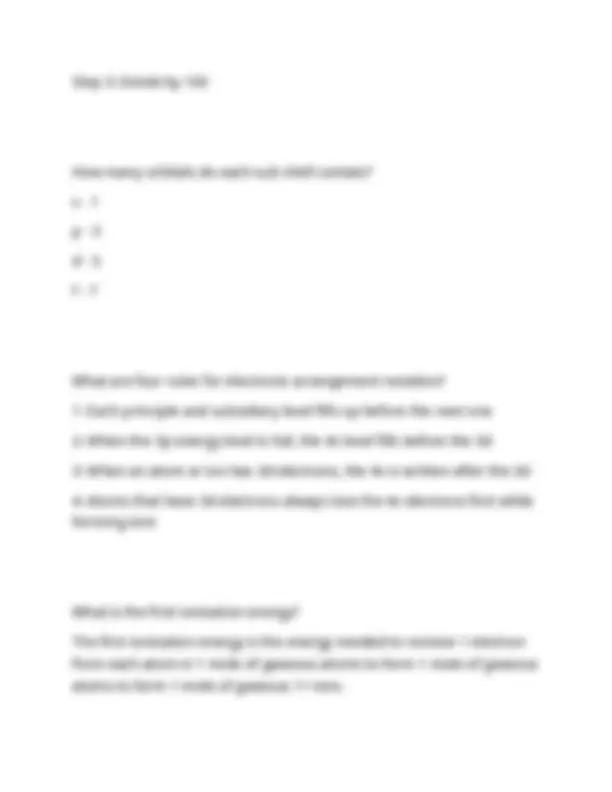
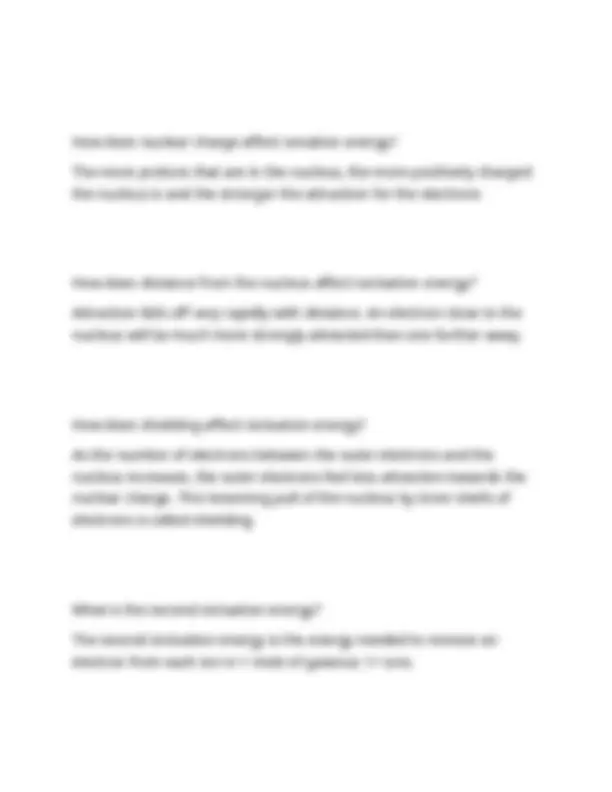
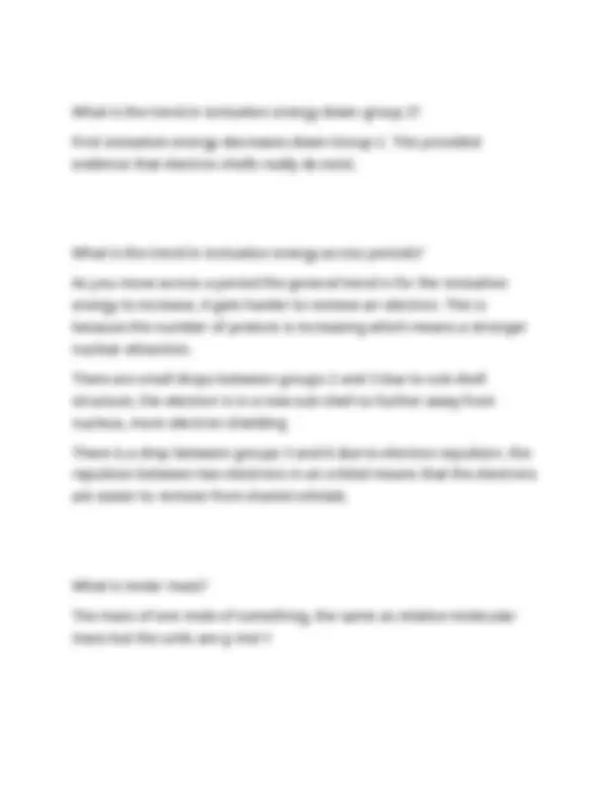
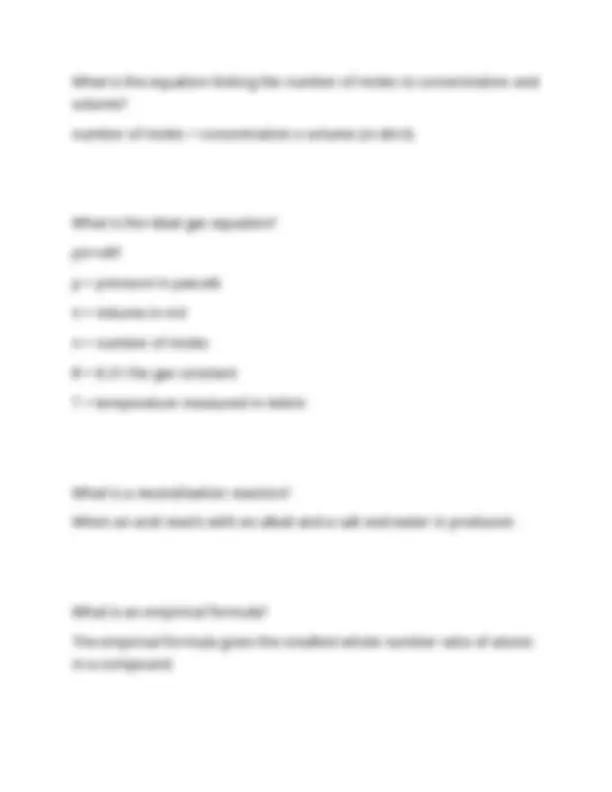
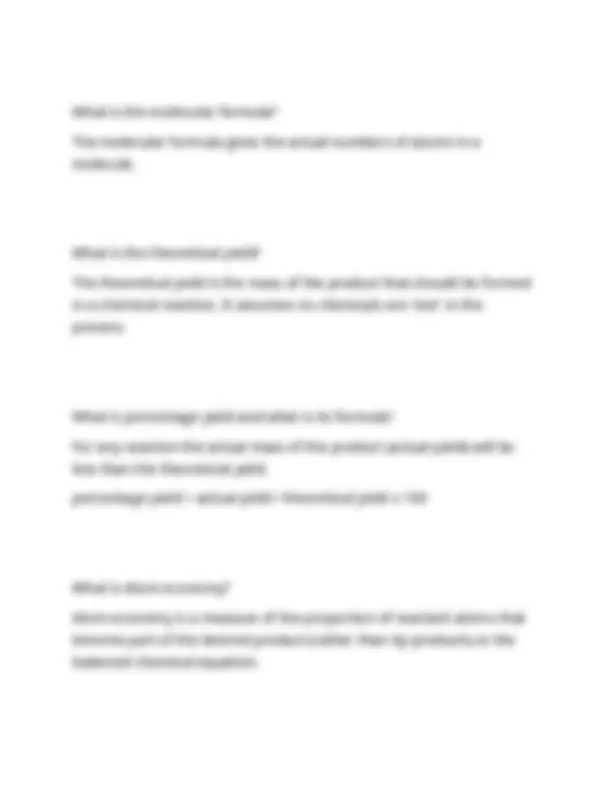
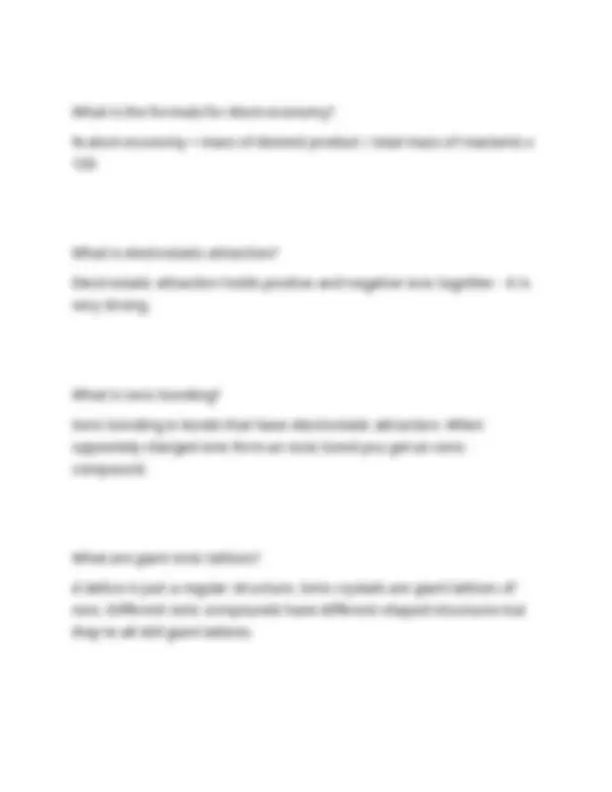
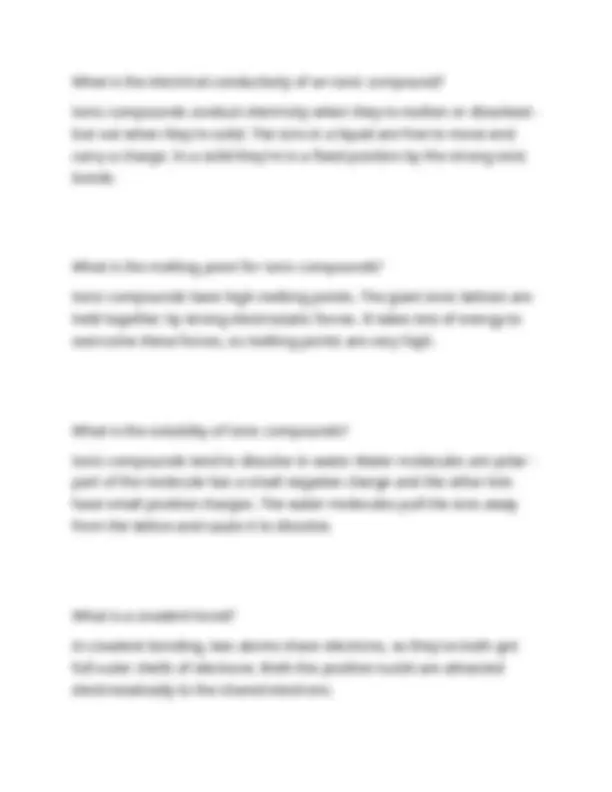
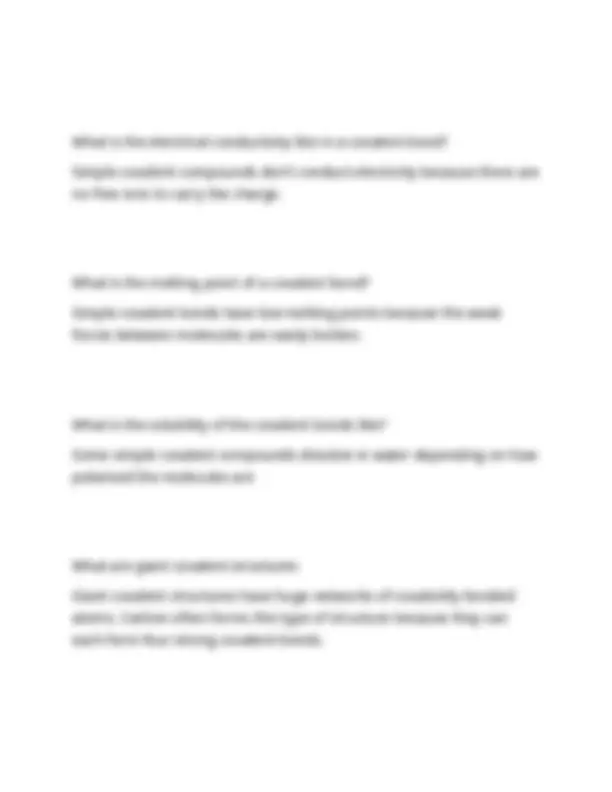

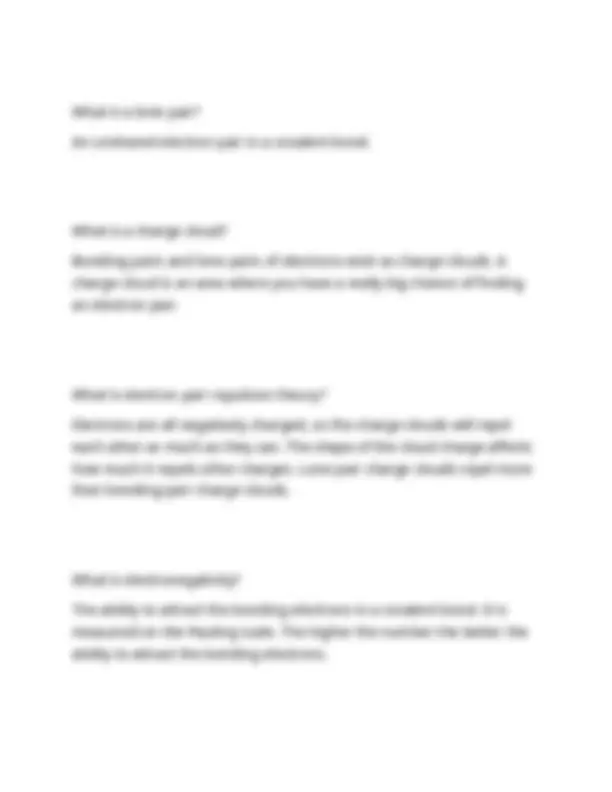
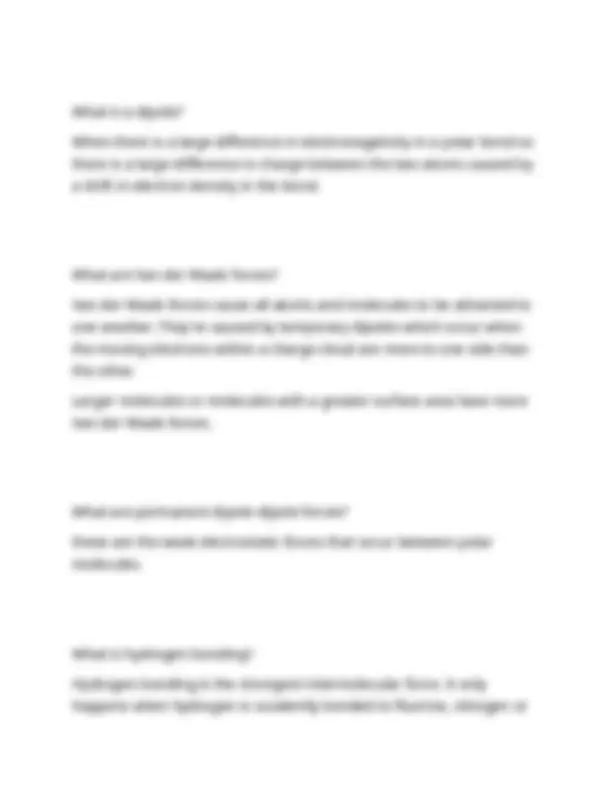
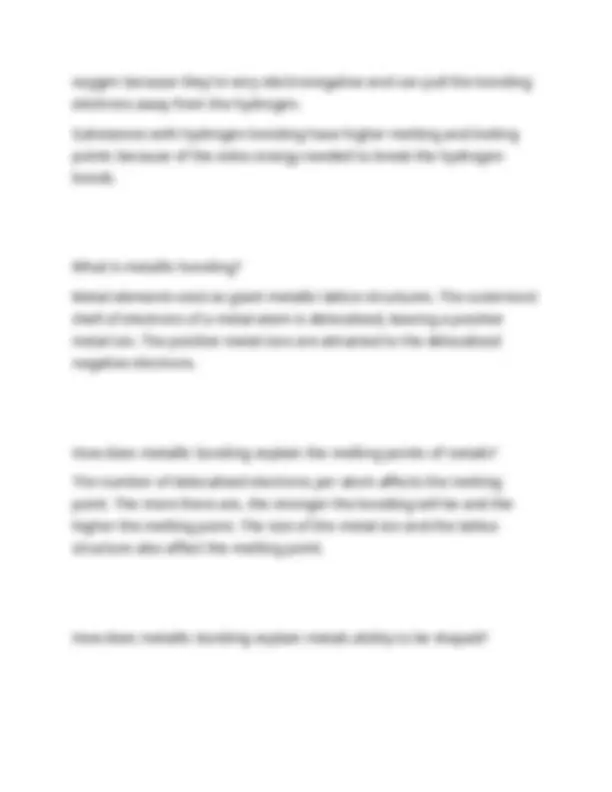
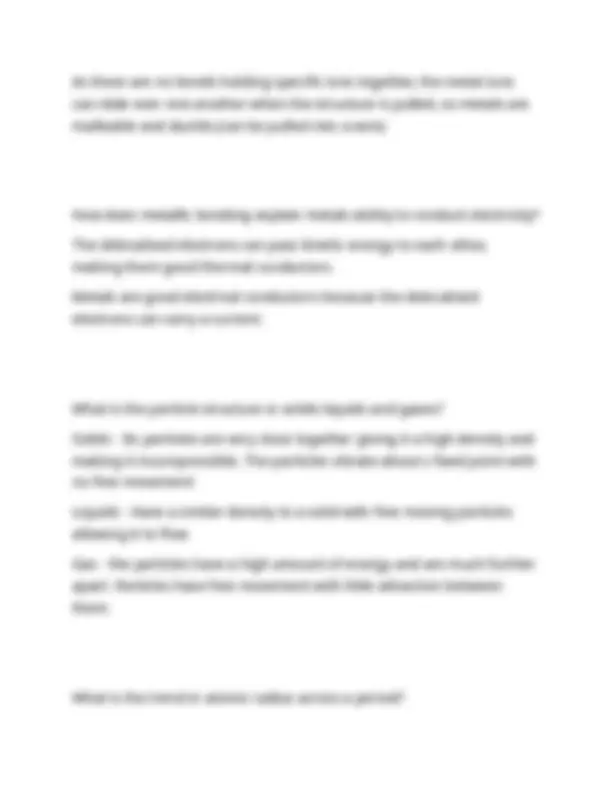
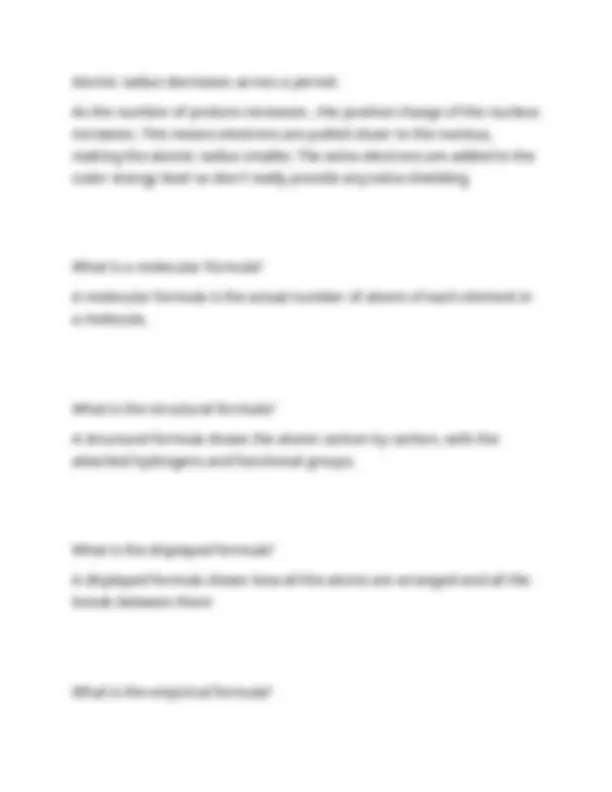
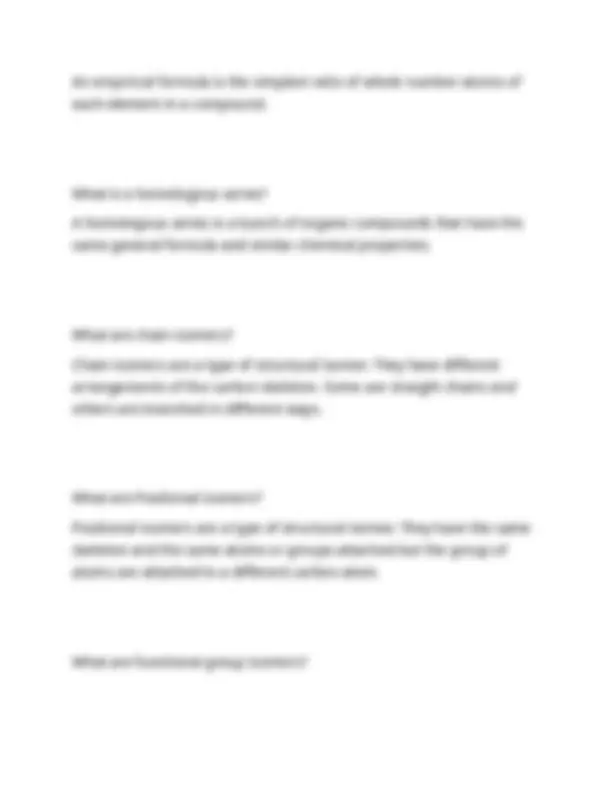

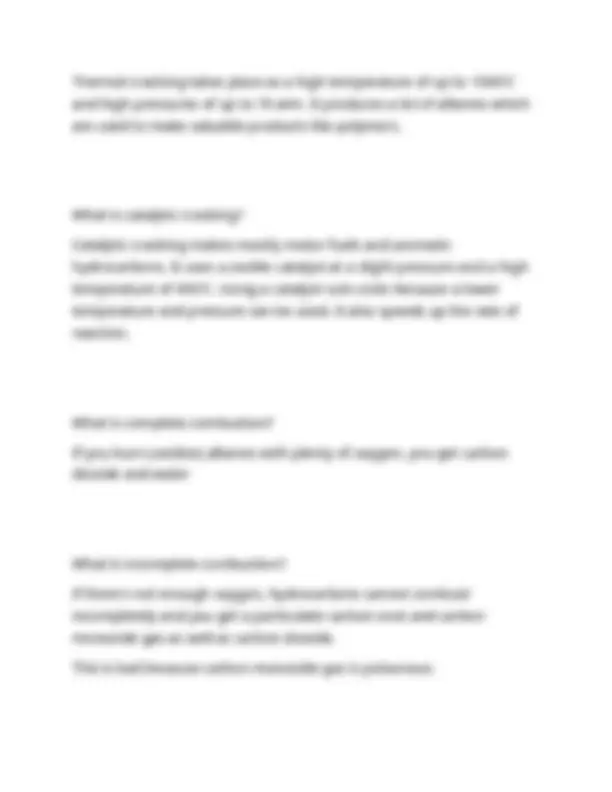
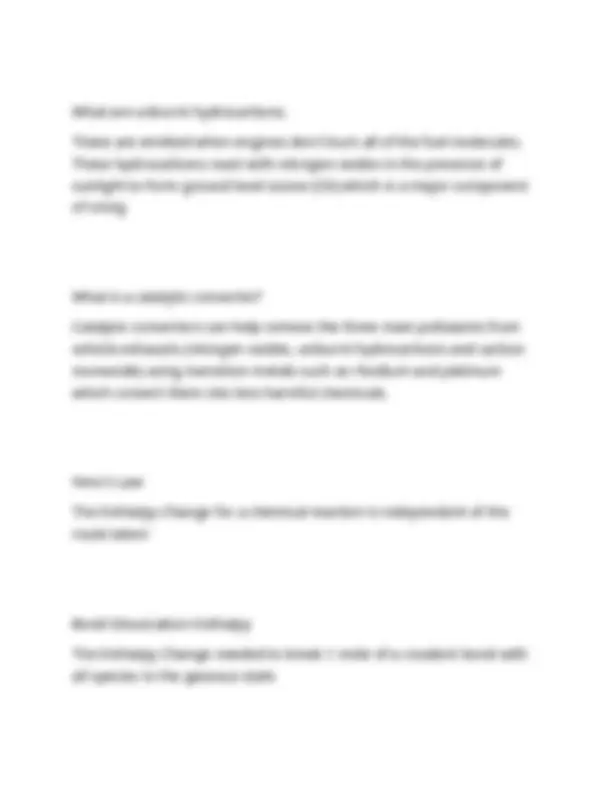
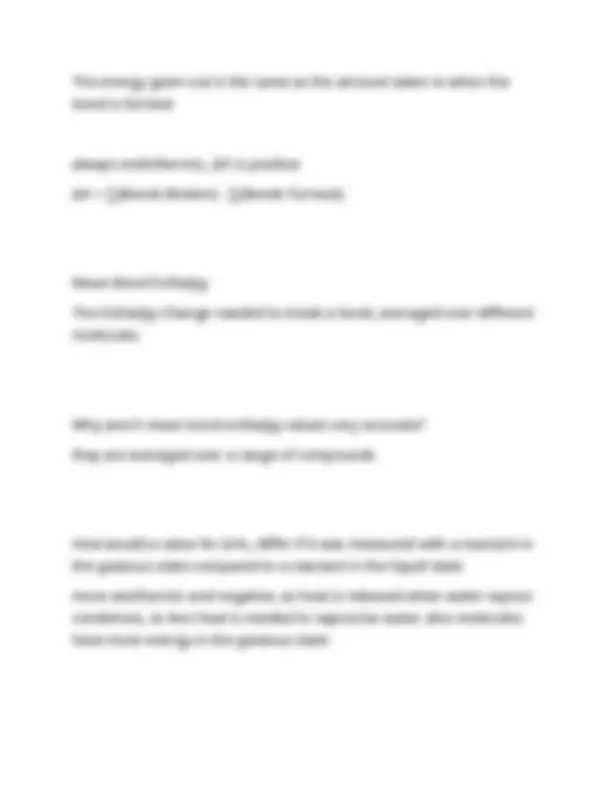
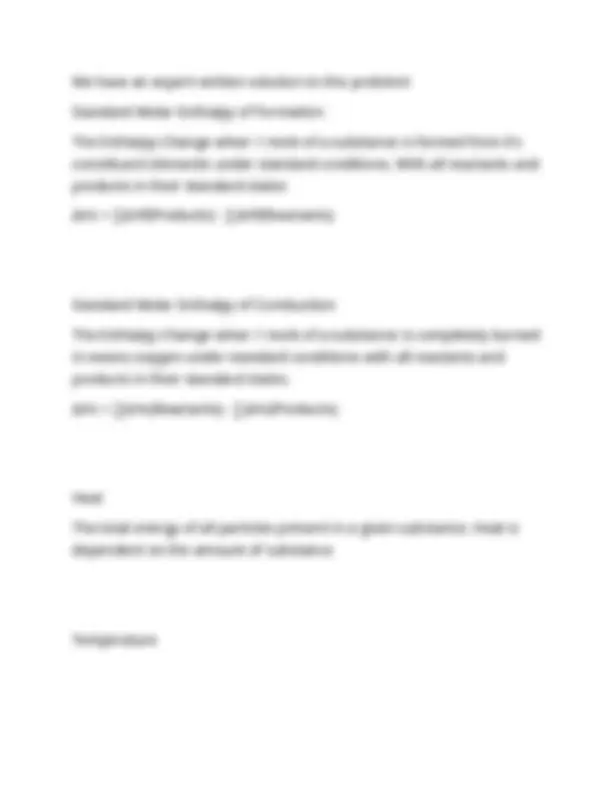
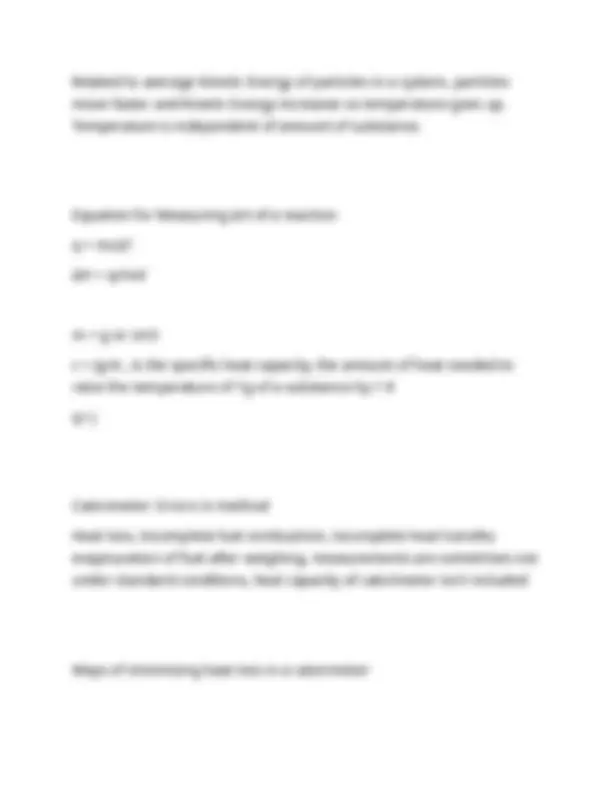


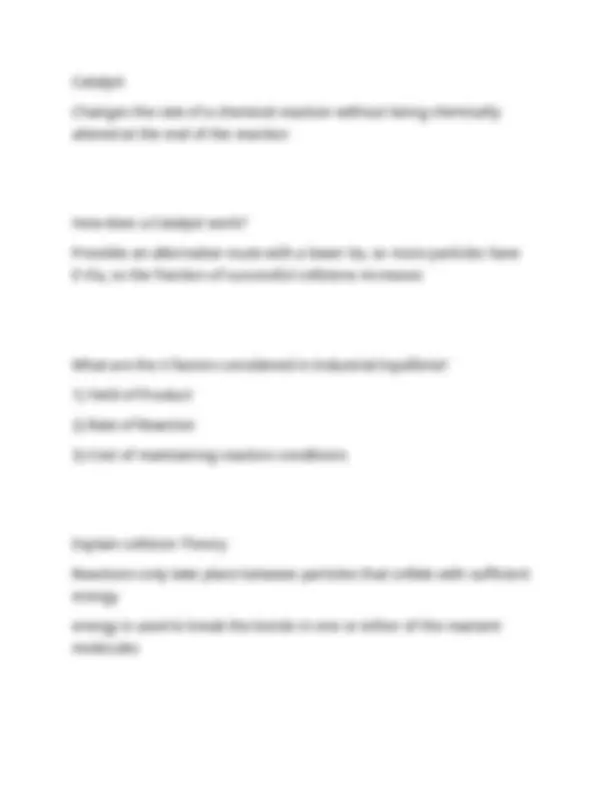


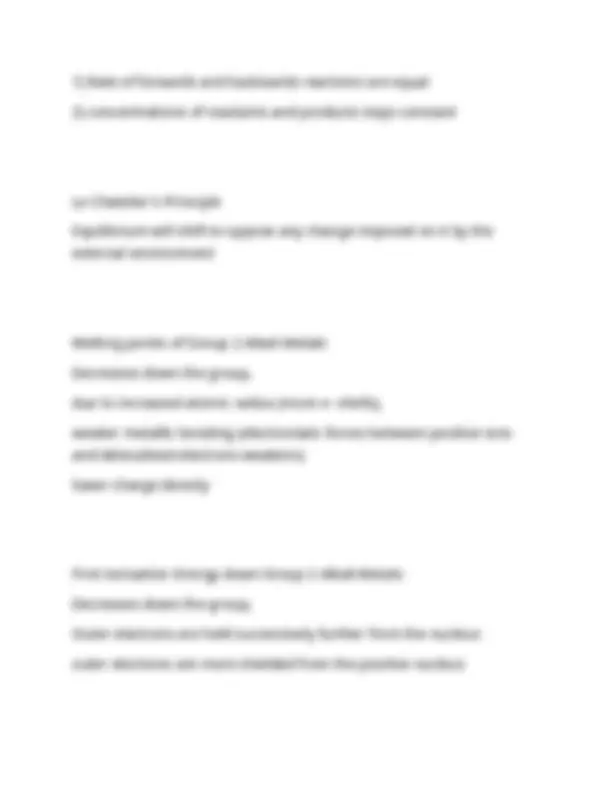
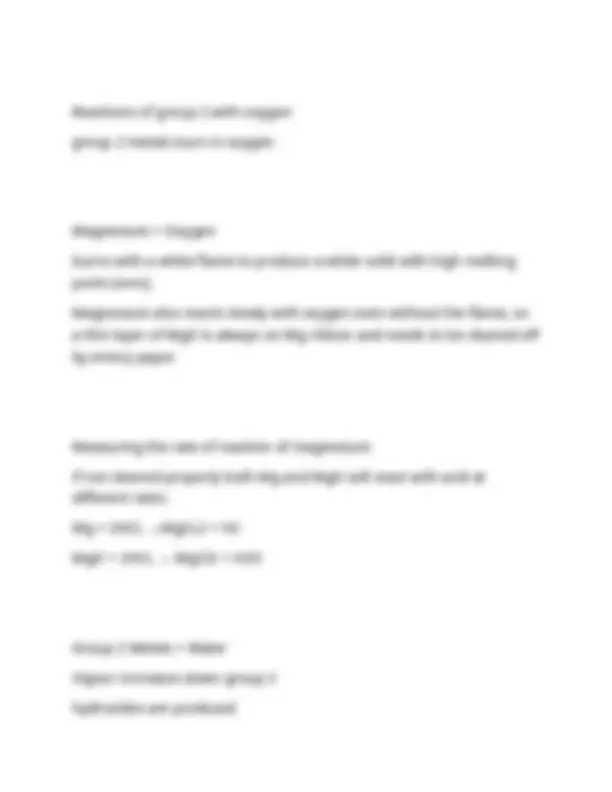
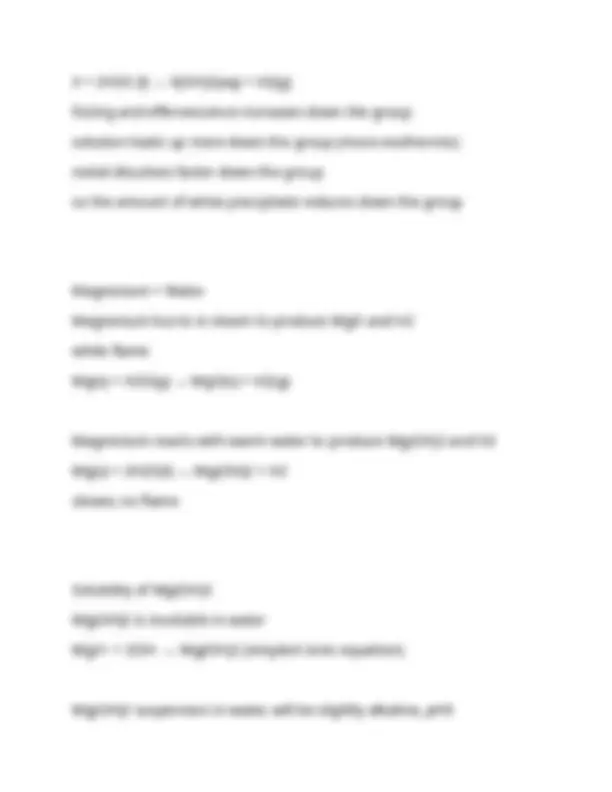
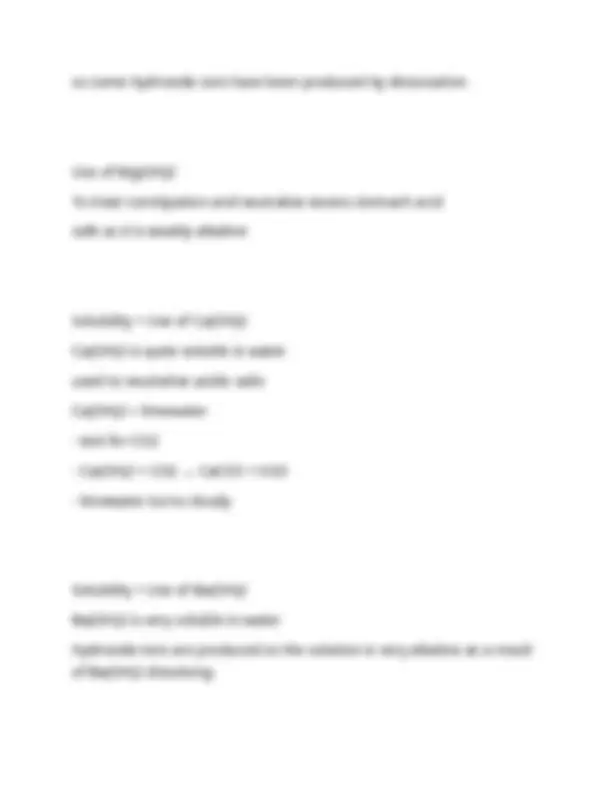
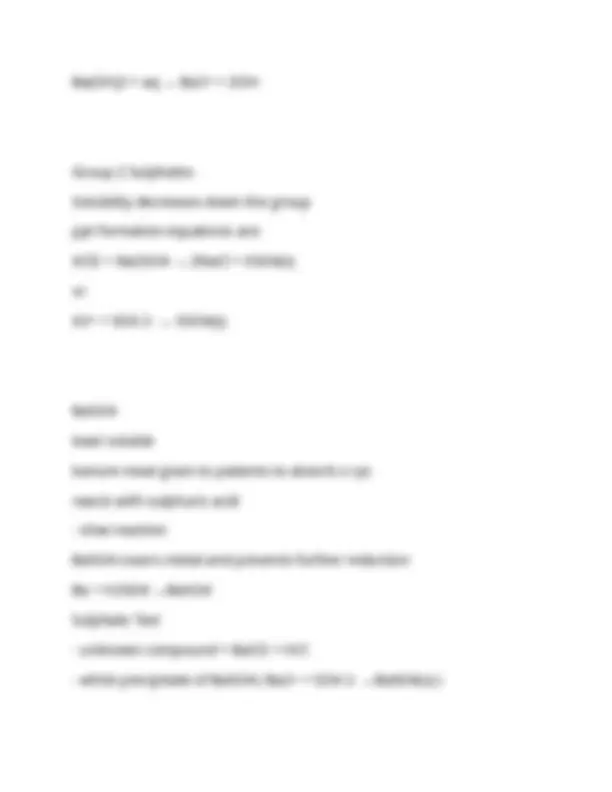
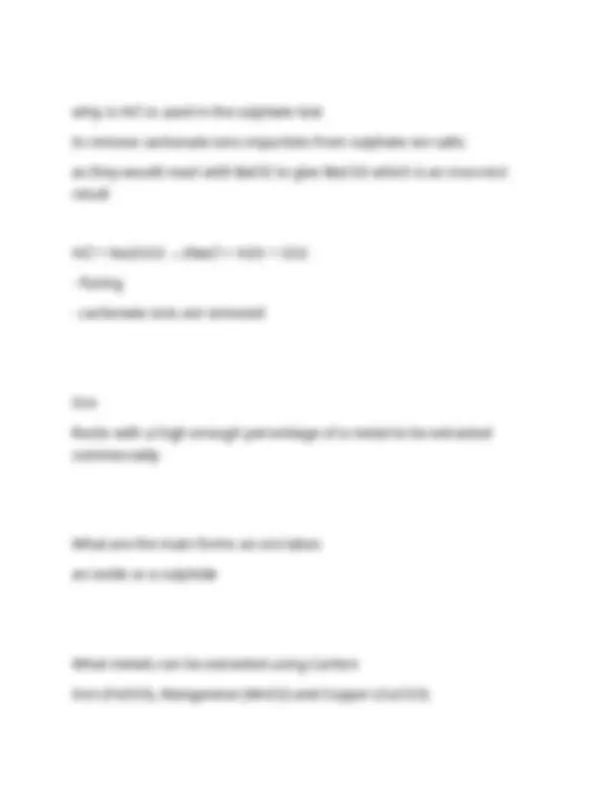

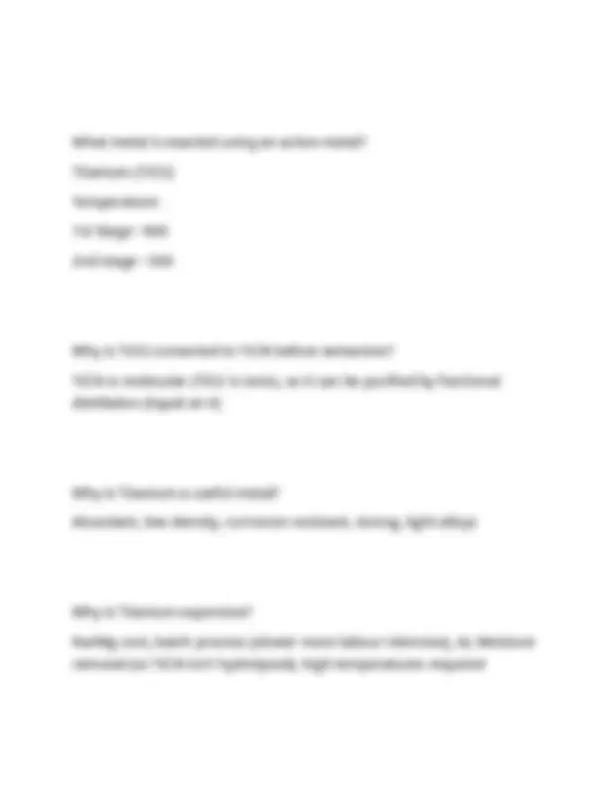
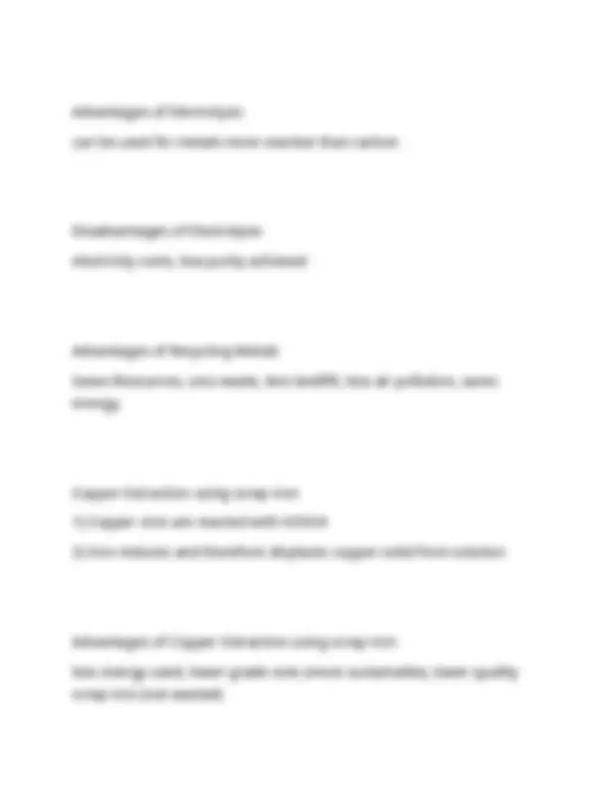
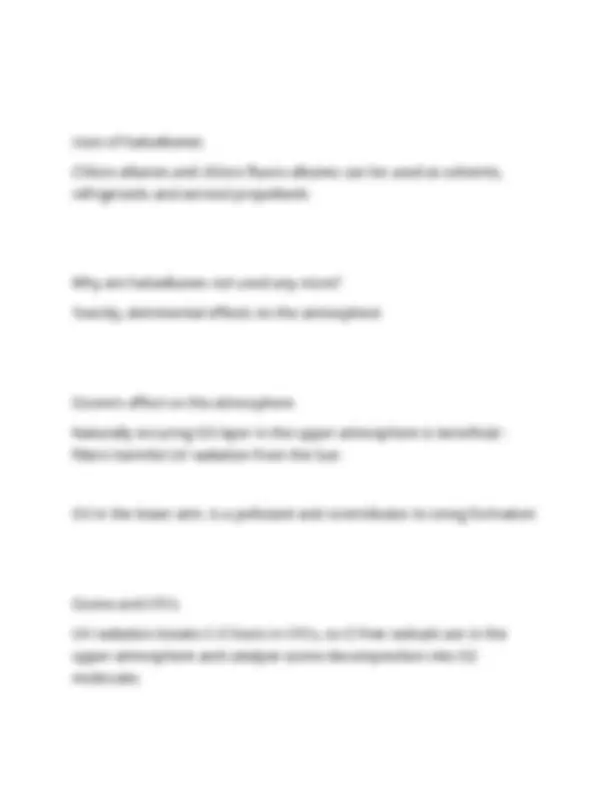

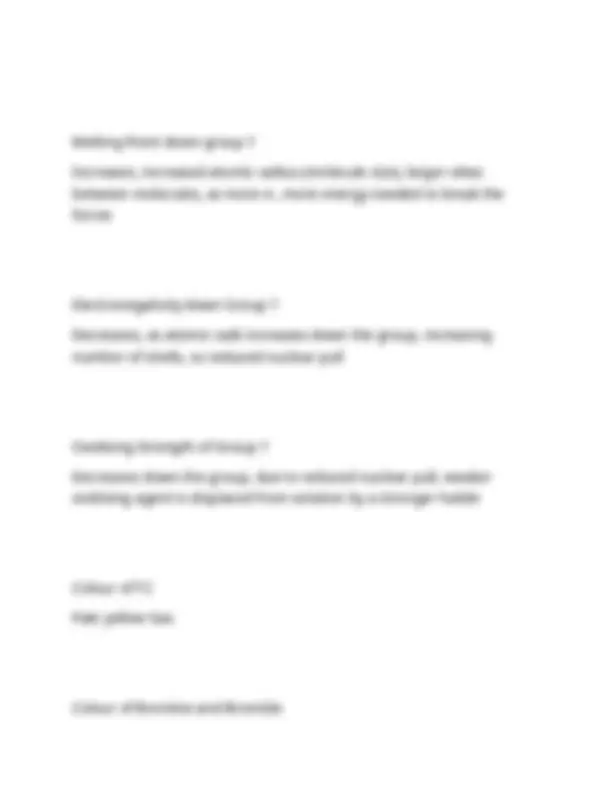
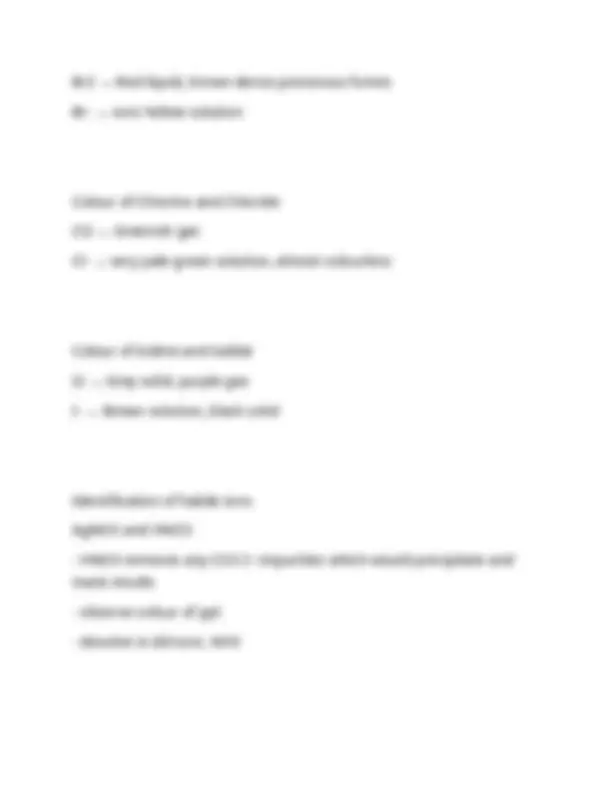
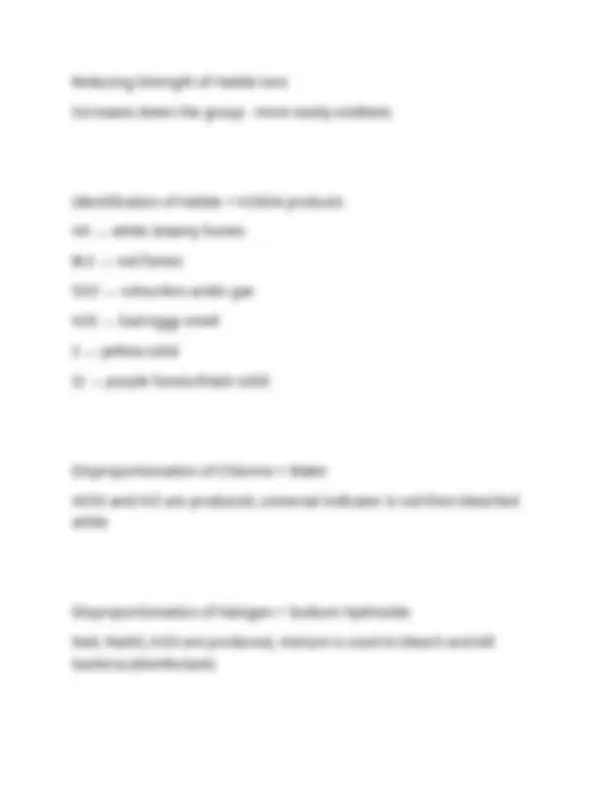
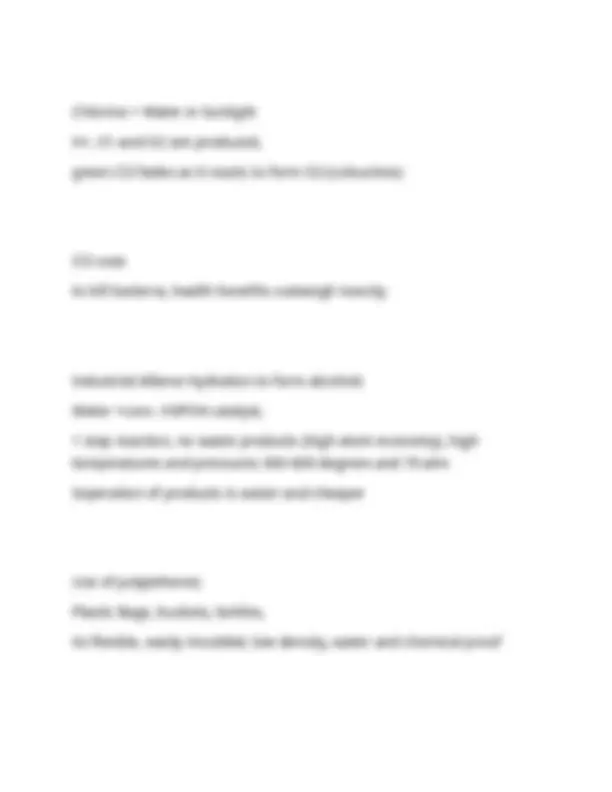
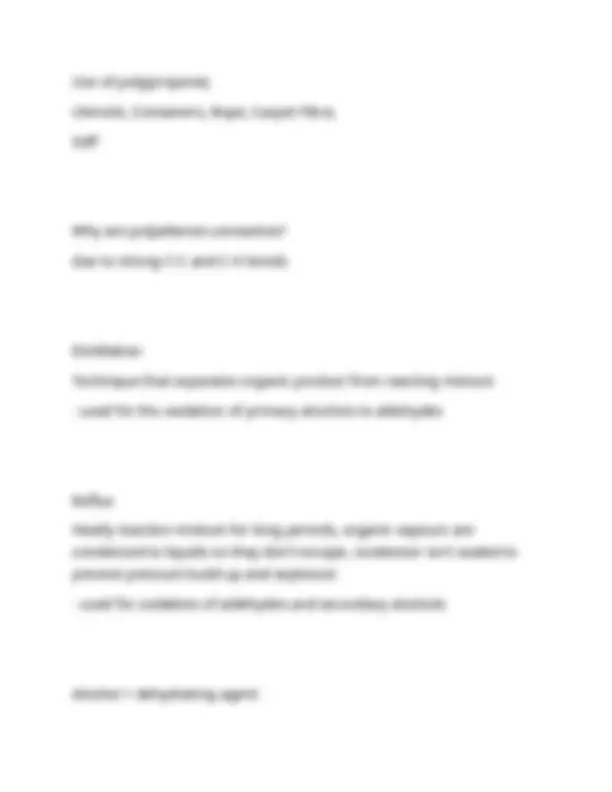
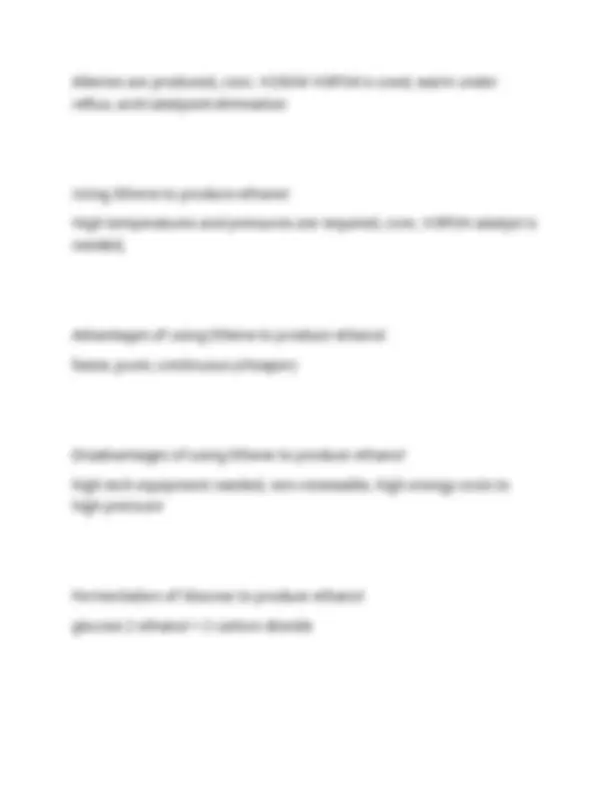
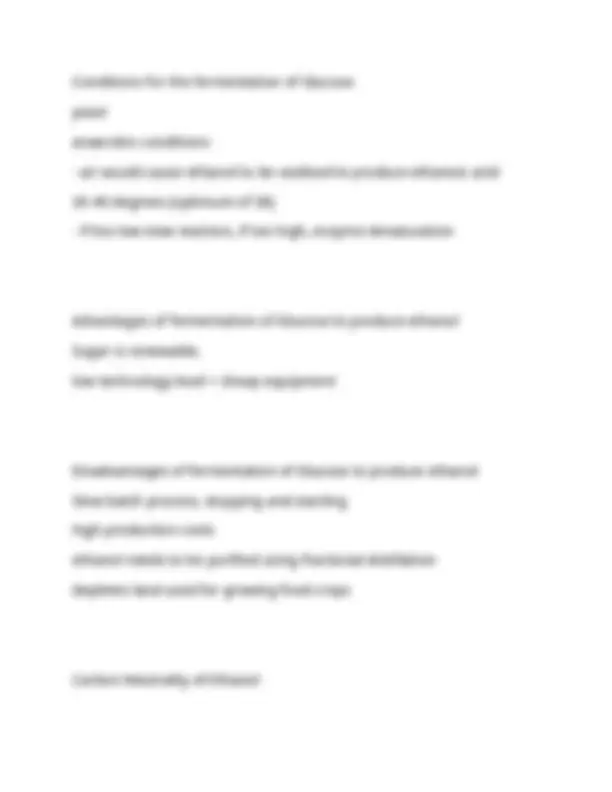

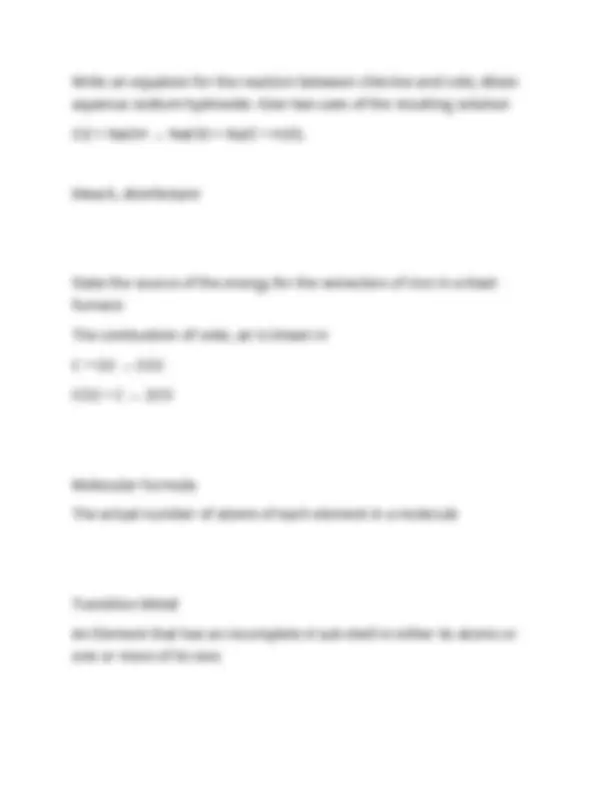
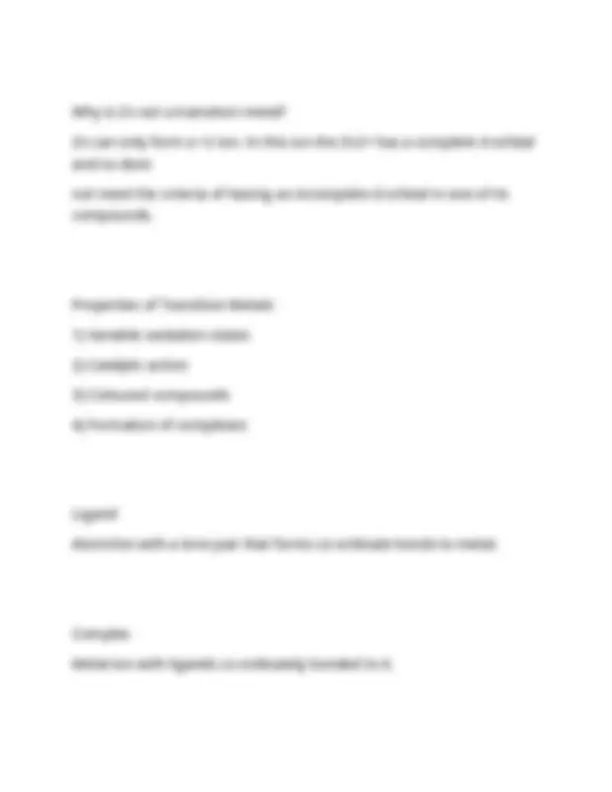

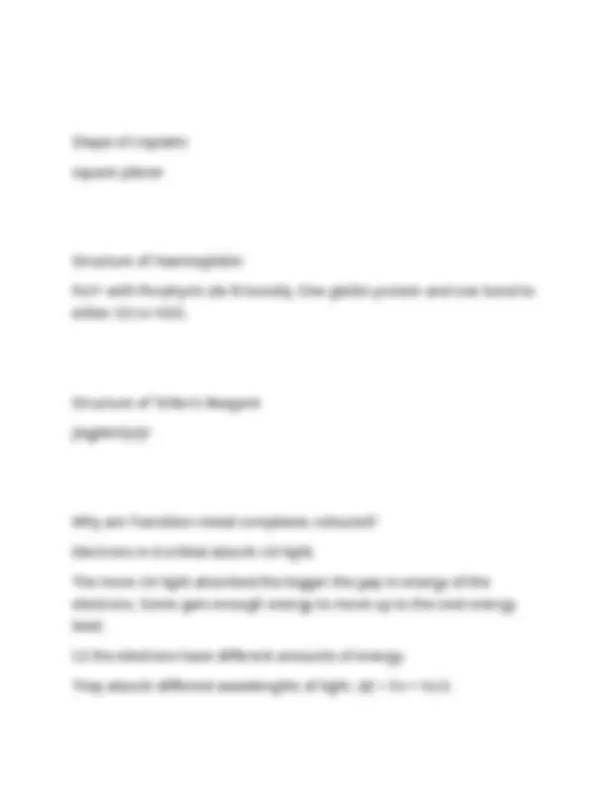
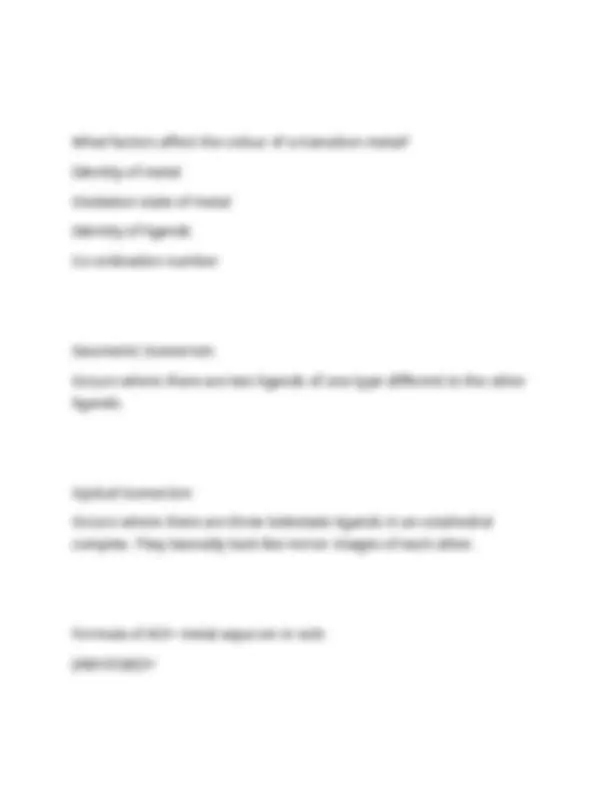



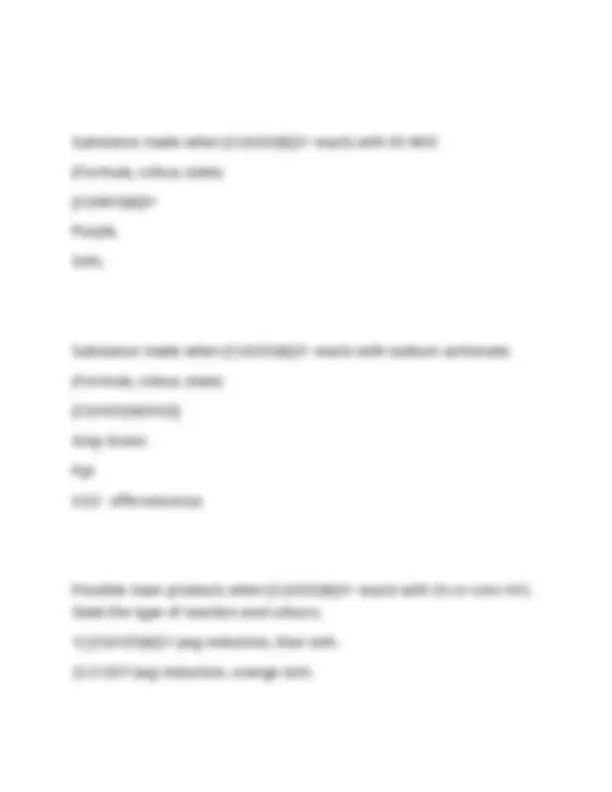












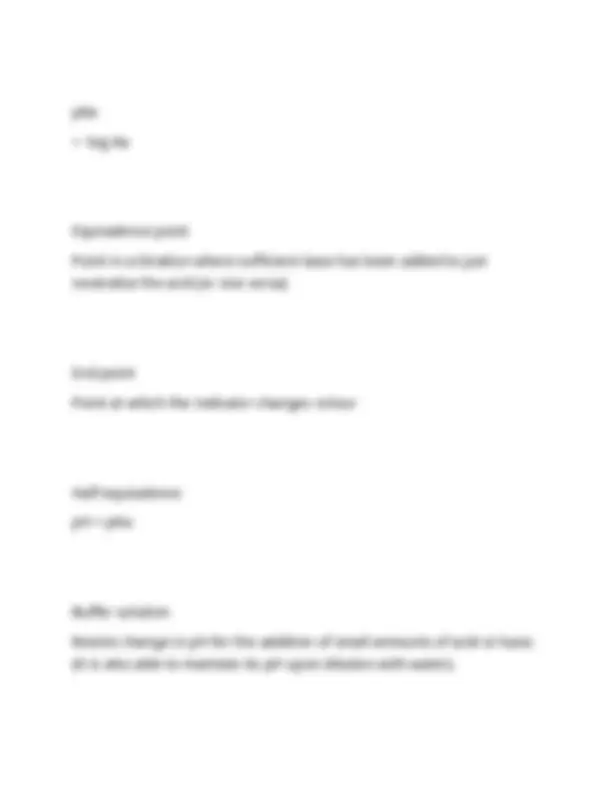



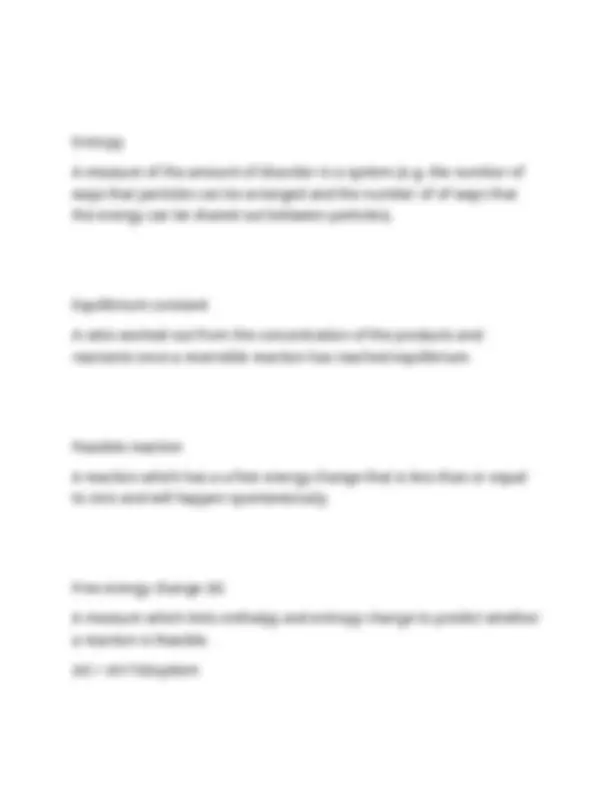




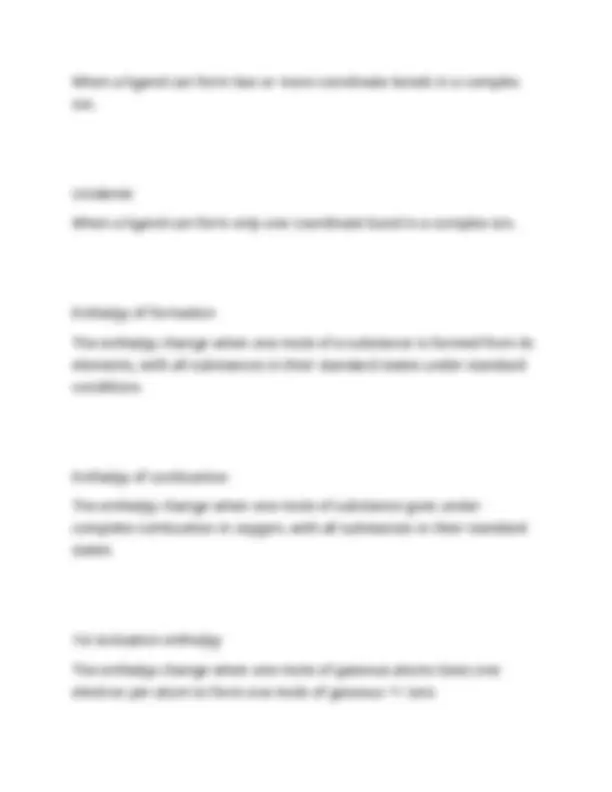
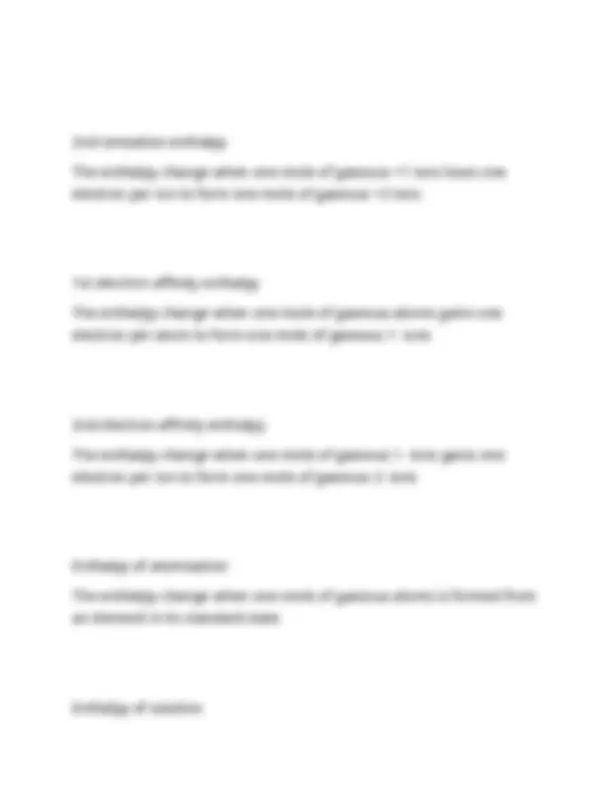
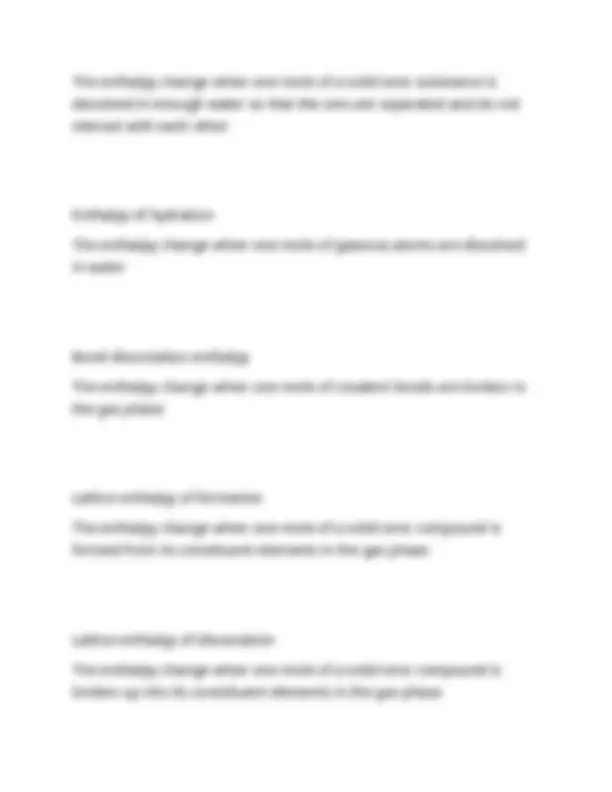





Study with the several resources on Docsity

Earn points by helping other students or get them with a premium plan


Prepare for your exams
Study with the several resources on Docsity

Earn points to download
Earn points by helping other students or get them with a premium plan
Community
Ask the community for help and clear up your study doubts
Discover the best universities in your country according to Docsity users
Free resources
Download our free guides on studying techniques, anxiety management strategies, and thesis advice from Docsity tutors
AQA CHEMISTRY A LEVEL 2025 PAPER WITH QUESTIONS AND CORRECT ANSWERS|PASS GUARANTEED
Typology: Exams
1 / 106

This page cannot be seen from the preview
Don't miss anything!





























































































What makes transition metal characteristics incomplete d sub-level in atoms or ions 4 main characteristics of Transition metals complex formation, formation of coloured ions, variable oxidation state, catalytic activity what is a complex a central metal ion surrounded by ligands what is a ligand An atom, ion or molecule which can donate a lone electron pair what is a coordinate bond
Co-ordinate bonding is when the shared pair of electrons in the covalent bond come from only one of the bonding atoms what is coordination number The number of co-ordinate bonds formed to a central metal ion why is carbon monoxide toxic CO is toxic to humans as CO can from a strong coordinate bond with hemoglobin. This is a stronger bond than that made with oxygen and so it replaces the oxygen attaching to the hemoglobin what is the chelate effect The substitution of monodentate ligand with a bidentate or a multidentate ligand leads to a more stable complex. This chelate effect can be explained in terms of a positive entropy change in these reactions as more molecules of products than reactants type of isomerism shown in square planar/octahedral complexes E-Z
how can you change color of transition metals Changing a ligand or changing the coordination number will alter the energy split between the d- orbitals, changing E and hence change the frequency of light absorbed describe the method of spectroscopy •Add an appropriate ligand to intensify colour •Make up solutions of known concentration (dilution series) •Measure absorption or transmission •Plot graph of absorption vs concentration •Measure absorption of unknown and compare general trend of variable oxidation states
VO2+ Oxidation state +5 ( a yellow solution) VO2+ Oxidation state + 4 (a blue solution) V3+ Oxidation state + 3 (a green solution) V2+ Oxidation state + 2 (a violet solution) YOU BETTER GET VANADIUM what is used to reduce vanadium Addition of zinc to the vanadium (V) in acidic solution will reduce the vanadium down through each successive oxidation state, and the color would successively change from yellow to blue to green to violet what is used in testing for aldehydes [Ag(NH3)2]+ is used in Tollen's reagent to distinguish between aldehydes and ketones. Aldehydes reduce the silver in the Tollen's reagent to silver why are dark colours of solutions difficult to measure The purple colour of manganate can make it difficult to see the bottom of meniscus in the burette.
what are standard conditions for heterogenous catalysts Heterogeneous catalysts are usually solids whereas the reactants are gaseous or in solution. The reaction occurs at the surface of the catalyst. how do heterogenous catalysts work Adsorption of reactants at active sites on the surface may lead to catalytic action. The active site is the place where the reactants adsorb on to the surface of the catalyst. This can result in the bonds within the reactant moleculesbecomingweaker,or themoleculesbeingheldin a more reactive configuration. There will also be a higher concentration of reactants at the solid surface so leading to a higher collision frequency. how does the strength of adsorption help to determine the effectiveness of the catalytic activity. Some metals e.g. W have too strong adsorption and so the products cannot be released. Some metals e.g. Ag have too weak adsorption, and the reactants do not adsorb in high enough concentration.
what is the effect of increasing surface area Increasing the surface area of a solid catalyst will improve its effectiveness. A support medium is often used to maximise the surface area and minimise the cost (e.g. Rh on a ceramic support in catalytic converters). contact process equation (manufacture of sulphuric acid) V2O5 is used as a catalyst in the Contact Process. Overall equation : 2SO2 + O2 --> 2SO3 step1 SO2 +V2O5 --> SO3 + V2O step 2 2V2O4 + O2 --> 2V2O what are the effects of catalytic poisoning Poisoning has a cost implication e.g. poisoning by sulphur in the Haber Process and by lead in catalytic converters in cars means that catalysts lose their efficiency and may need to be replaced. reaction between iodide and persulphate ions The reaction between I- and S2O82- catalysed by Fe2+ The uncatalysed reaction is very slow because the reaction needs a collision between two negative ions. Repulsion between the ions is going to hinder this - meaning high activation energy.
what is a lewis base electron pair donor (ligand) colour of hexaaqua iron (II) green colour of hexaaqua copper (II) blue colour of hexaaqua aluminium (III) colourless (not a transition metal) colour of hexaaqua iron (III) violet
what is a hydrolysis/acidity reaction addition of water/removal of a hydrogen [M(H2O)6]2+ + H2O --> [M(H2O)5(OH)]+ + H3O+ why are 3+ ions more acidic than 2+ The acidity of [M(H2O)6]3+ is greater than that of [M(H2O)6]2+ in terms of the greater polarising power (charge/size ratio) of the 3+ metal ion. The greater the polarising power, the more strongly it attracts the water molecule. This weakens the O-H bond so it breaks more easily. Precipitate of Copper (II) with hydroxide or NH3 (deprotonation acid- base reaction) blue Precipitate of Iron (II) with hydroxide or NH3 (deprotonation acid-base reaction) green
what happens with M3+ ions with carbonates The 3+ ions with carbonate solution form a M(OH)3 ppt and CO2 gas is evolved why is a carbonate salt not formed with metal 3+ ions MCO3 is formed with 2+ ions but M2(CO3)3 is not formed with 3+ ions. The difference is explained by the greater polarising power of the 3+ ion due to its higher charge density. precipitates formed in the carbonate (acidity reactions) Al forms white ppt of Al(OH)3 (H2O)3 + CO2 Fe(III) forms brown ppt of Fe(OH)3 (H2O)3 + CO What is the relative mass and charge on a proton? Mass 1 charge +
What is the relative mass and charge on a neutron? Mass 1 Charge 0 What is the relative mass and charge on an electron? Mass 1/ Charge - What is the mass number? The total number of protons and neutrons in the nucleus of an atom What is the Atomic (proton) number? This is the number of protons in the nucleus of an atom and is used to identify an element What are Ions?
A tiny positively charged nucleus at the centre, surrounded by a cloud of negative electrons. Most of the atom is empty space. What did Bohr's atom model show? Electrons only exist in fixed orbits and not anywhere in between. Each Shell has a fixed energy. When an electron moves between shells, electromagnetic radiation is emitted or absorbed. Because the energy of the shells is fixed, the radiation will have a fixed energy. What difference is found between the original Bohr atom model and the refined Bohr model? Scientists discovered that not all electrons in a shell have the same energy, so it was refined to include sub shell's. What is relative atomic mass? The average mass of an atom of an element compared to one twelfth of the mass of an atom of carbon 12.
What is relative isotopic mass? Relative isotopic mass is the mass of an atom of an isotope of an element on a scale where an atom of Carbon-12 is exactly 12. Calculating relative atomic mass relative atomic mass = isotopic masses x percentages/total percentage What is relative molecular mass? The average mass of an entity compared to one twelfth of the mass of an atom of carbon 12. What is the equation used to calculate the number of moles of any substance? Number of moles = mass(g)/ mass of one mole (mol) What are the 5 stages in mass spectrometery? vaporisation, ionisation, acceleration, deflection, and detection
What happens during the detection stage of mass spectrometry? The positive ions hit an electrically charged plate/ the current produced is then amplified and recorded as a 'peak'. Each peak is a measure of the relative abundance of each ion. What is the general ionisation equation? X(g) => X+ = e- What does a mass spectrum chart show? Each line represents a different isotope of an element. the height of each peak gives the relative isotopic abundance (the amount of it). For a molecular substance the peak with the greatest m/z ratio corresponds to the Mr. What are the steps in calculating relative atomic mass? Step 1: For each peak multiply the relative isotopic abundance by the relative isotopic mass. Step 2: Add up these totals.
Step 3: Divide by 100 How many orbitals do each-sub shell contain? s - 1 p - 3 d - 5 f - 7 What are four rules for electronic arrangement notation? 1: Each principle and subsidiary level fills up before the next one 2: When the 3p energy level is full, the 4s level fills before the 3d 3: When an atom or ion has 3d electrons, the 4s is written after the 3d 4: Atoms that have 3d electrons always lose the 4s electrons first while forming ions What is the first ionisation energy? The first ionisation energy is the energy needed to remove 1 electron from each atom in 1 mole of gaseous atoms to form 1 mole of gaseous atoms to form 1 mole of gaseous 1+ ions.